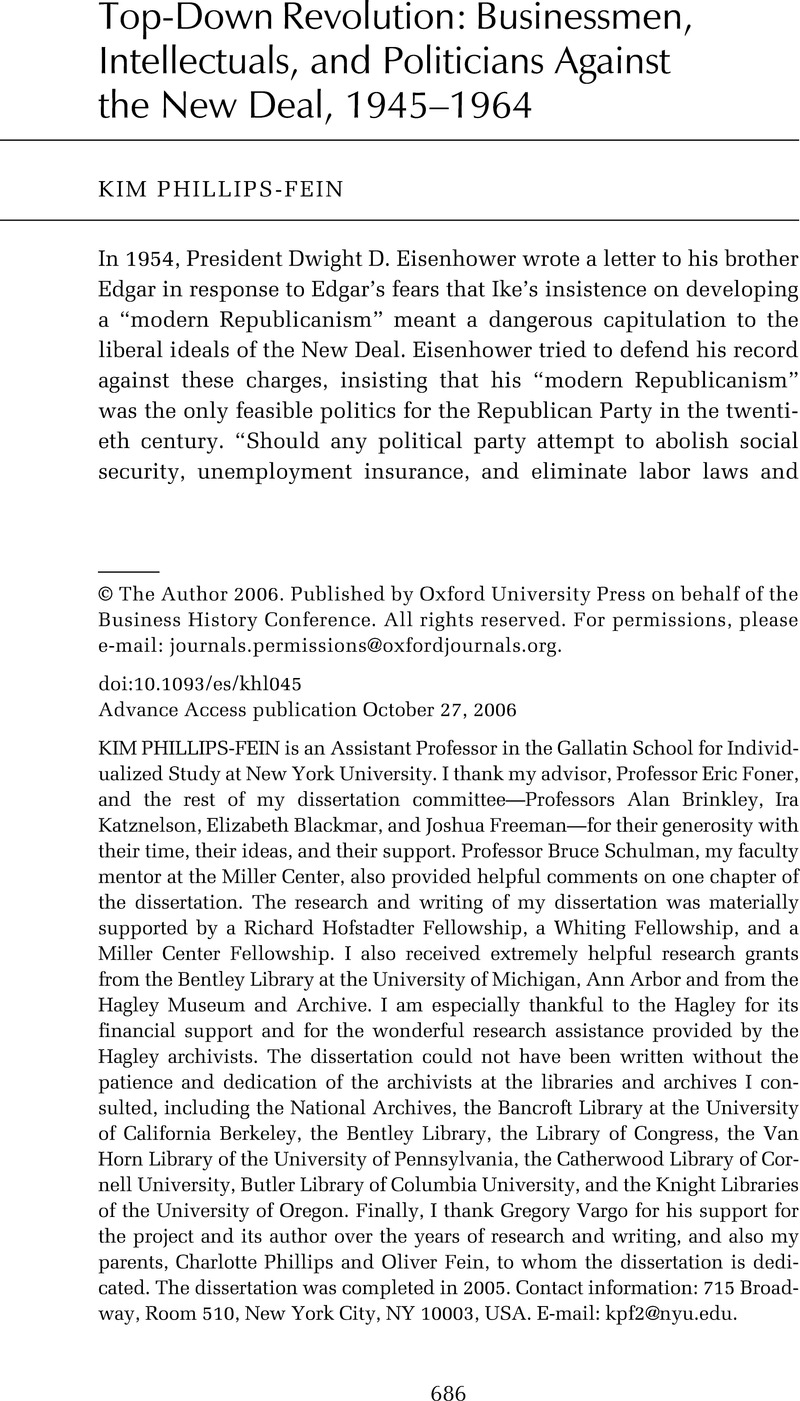Published online by Cambridge University Press: 18 February 2015

1. Eisenhower, Dwight D. to Eisenhower, Edgar, 8 Nov. 1954, doc. 1147, in The Papers of Dwight David Eisenhower, ed. Galambos, L. and van Ee, D.. World Wide Web facsimile by The Dwight D. Eisenhower Memorial Commission of the print edition (Baltimore, Md., 1996). URL: http://www.eisenhowermemorial.org/presidential-papers/first-term/documents/1147.cfm.Google Scholar
2. Harris, Howell John, The Right to Manage: Industrial Relations Policies of American Business in the 1940s (Madison: University of Wisconsin Press, 1982)Google Scholar and Fones-Wolf, Elizabeth, Selling Free Enterprise: The Business Assualt on Labor and Liberalism, 1945-1960 (Urbana and Champaign: University of Illinois Press, 1994)Google Scholar are two excellent books that also chart continued criticism of New Deal liberalism in the business community.
3. For example, see Rieder, Jonathan, Canarsie: The Jews and Italians of Brooklyn against Liberalism (Cambridge, Mass., 1995)Google Scholar; Carter, Dan, The Politics of Rage: George Wallace, The Origins of the New Conservatism, and the Transformation of American Politics (New York, 1995)Google Scholar.
4. See Rosenberg, Samuel, American Economic Development Since 1945: Growth, Decline and Rejuvenation (New York, 2003)CrossRefGoogle Scholar.
5. Crane, Jasper to Miller, Loren, 14 Sept. 1945, Jasper Crane Papers, Box 51, Hagley Museum and Library, Delaware.Google Scholar
6. Crane, Jasper to Miller, Loren, 13 Nov. 1945, Jasper Crane Papers, Box 51, Hagley Museum and Library, Delaware.Google Scholar
7. See Phillips-Fein, , “Top-Down Revolution,” chap 2. Nash, George, The Conservative Intellectual Movement in America Since 1945 (New York, 1976)Google Scholar remains the classic account of the development of postwar intellectual conservatism. However, Nash says little about the role of business support in building conservative intellectual institutions. Hartwell, R. M., A History of the Mont Pelerin Society (Indianapolis, Ind., 1995)Google Scholar, mentions Crane’s support for Mont Pelerin but says little about the intellectual and political commitments that led to this support. Dieter Plehwe, Bernard Walpen, and Philip Mirowski are currently working on a collection of essays on the history of the Mont Pelerin Society that will place its intellectual work in a broader political context.
8. For accounts of the strike and Boulware’s hire, see Northrup, Herbert, Boul-warism (Ann Arbor, Mich., 1964)Google Scholar, and Matles, James and Higgins, James, Them and Us: Struggles of a Rank-and-File Union (Engelwood Cliffs, N.J., 1974)Google Scholar. Also see Schatz, Ronald, The Electrical Workers: A History of Labor at General Electric and Westinghouse, 1923-1960 (Urbana, Ill., 1983)Google Scholar.
9. “Proposed Program of Industrial and Community Relations,” 1 Aug. 1945. Atop the memo is a handwritten note from CEO Wilson, Charles: “Mr. Boulware: A splendid contribution, I think. Give it wide distribution.” Lemuel Boulware Papers, MS Coll. 52, Box 8, Folder 154, Van Pelt Library, University of Pennsylvania, Philadelphia.Google Scholar
10. “Highlights of the General Electric Economic Education Program,” Box 52, Archive Organization Files, Kheel Library for Labor-Management Co-operation, Catherwood Library, Cornell University, New YorkGoogle Scholar. Also see Kannenberg, Lisa Ann, “The Product of GE’s Progress: Labor, Management and Community Relations in Schenectady, 1930-1960” (Ph.D. diss., Rutgers University, 1999), 215.Google Scholar
11. Boulware, Lemuel, The Truth About Boulwarism: Trying to Do Right Voluntarily (Washington, D.C., 1969), 30–38.Google Scholar
12. For Peter Steele, see Peter Steele Papers, Box 2, Correspondence D-G, Knight Libraries, University of Oregon, Eugene. For Ronald Reagan, see Wills, Garry, Reagan’s America: Innocents at Home (New York, 1987)Google Scholar.
13. See AEA pamphlet in W. C. Mullendore Papers, Carton 2, Knight Library, University of Oregon. Also see Smith, James A., The Idea Brokers: Think Thanks and the Rise of the New Policy Elite (New York, 1991)Google Scholar and Blumenthal, Sidney, The Rise of the Counter-Establishment: From Conservative Ideology to Political Power (New York, 1986)Google Scholar for discussions of the early history of AEA. Rosenfeld, Sam, “From Lobbyists to Scholars: AEI and the Politics of Expertise, 1943–1964” (Senior Thesis, Columbia University, April 2004)Google Scholar, is the best essay available on AEA’s early development.
14. Baroody, William to McGrath, William, 17 Aug. 1954, Box 40, Folder 4, William Baroody Papers, Library of Congress, Washington, D.C.Google Scholar
15. Correspondence, 8 Jan. 1958 and 6 Jan. 1958, Box 42, Folder 8, William Baroody Papers.
16. White, F. Clifton, Politics as a Noble Calling (Ottawa, Ill., 1994), 112.Google Scholar
17. Lane, L. B. of the Lane Company in Altavista, Virginia, to Sligh, Charles, 24 Feb. 1956. Folder labeled “February 1956 correspondence,” Box 11, Sligh Family Papers, Bentley Library, University of Michigan at Ann Arbor.Google Scholar
18. De Mille, Cecil B. to Finch, Robert, 31 July 1958, Box 119, William F. Know-land Papers, Bancroft Library, University of California at Berkeley.Google Scholar